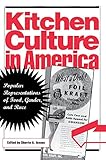Kitchen Culture in America : Popular Representations of Food, Gender, and Race / ed. by Sherrie A. Inness.
Material type: TextPublisher: Philadelphia : University of Pennsylvania Press, [2015]Copyright date: ©2000Description: 1 online resource (296 p.) : 29 illusContent type:
TextPublisher: Philadelphia : University of Pennsylvania Press, [2015]Copyright date: ©2000Description: 1 online resource (296 p.) : 29 illusContent type: - 9780812217353
- 9781512802887
- 392.3/7/0973 21
- GT2853.U5
- online - DeGruyter
- Issued also in print.
| Item type | Current library | Call number | URL | Status | Notes | Barcode | |
|---|---|---|---|---|---|---|---|
 eBook
eBook
|
Biblioteca "Angelicum" Pont. Univ. S.Tommaso d'Aquino Nuvola online | online - DeGruyter (Browse shelf(Opens below)) | Online access | Not for loan (Accesso limitato) | Accesso per gli utenti autorizzati / Access for authorized users | (dgr)9781512802887 |
Frontmatter -- Contents -- Introduction -- 1. Bonbons, Lemon Drops, and Oh Henry! Bars -- 2. Campbell's Soup and the Long Shelf Life of Traditional Gender Roles -- 3. "Now Then-Who Said Biscuits?" -- 4. The Joy of Sex Instruction -- 5. "The Enchantment of Mixing-Spoons" -- 6. Home Cooking -- 7. Processed Foods from Scratch -- 8. Freeze Frames -- 9. She Also Cooks -- 10. "My Kitchen Was the World" -- 11. "If I Were a Voodoo Priestess" -- Contributors -- Index -- Acknowledgments
restricted access online access with authorization star
http://purl.org/coar/access_right/c_16ec
At supermarkets across the nation, customers waiting in line-mostly female-flip through magazines displayed at the checkout stand. What we find on those magazine racks are countless images of food and, in particular, women: moms preparing lunch for the team, college roommates baking together, working women whipping up a meal in under an hour, dieters happy to find a lowfat ice cream that tastes great. In everything from billboards and product packaging to cooking shows, movies, and even sex guides, food has a presence that conveys powerful gender-coded messages that shape our society.Kitchen Culture in America is a collection of essays that examine how women's roles have been shaped by the principles and practice of consuming and preparing food. Exploring popular representations of food and gender in American society from 1895 to 1970, these essays argue that kitchen culture accomplishes more than just passing down cooking skills and well-loved recipes from generation to generation. Kitchen culture instructs women about how to behave like "correctly" gendered beings. One chapter reveals how juvenile cookbooks, a popular genre for over a century, have taught boys and girls not only the basics of cooking, but also the fine distinctions between their expected roles as grown men and women. Several essays illuminate the ways in which food manufacturers have used gender imagery to define women first and foremost as consumers. Other essays, informed by current debates in the field of material culture, investigate how certain commodities like candy, which in the early twentieth century was advertised primarily as a feminine pleasure, have been culturally constructed. The book also takes a look at the complex relationships among food, gender, class, and race or ethnicity-as represented, for example, in the popular Southern black Mammy figure. In all of the essays, Kitchen Culture in America seeks to show how food serves as a marker of identity in American society.
Issued also in print.
Mode of access: Internet via World Wide Web.
In English.
Description based on online resource; title from PDF title page (publisher's Web site, viewed 24. Apr 2022)


